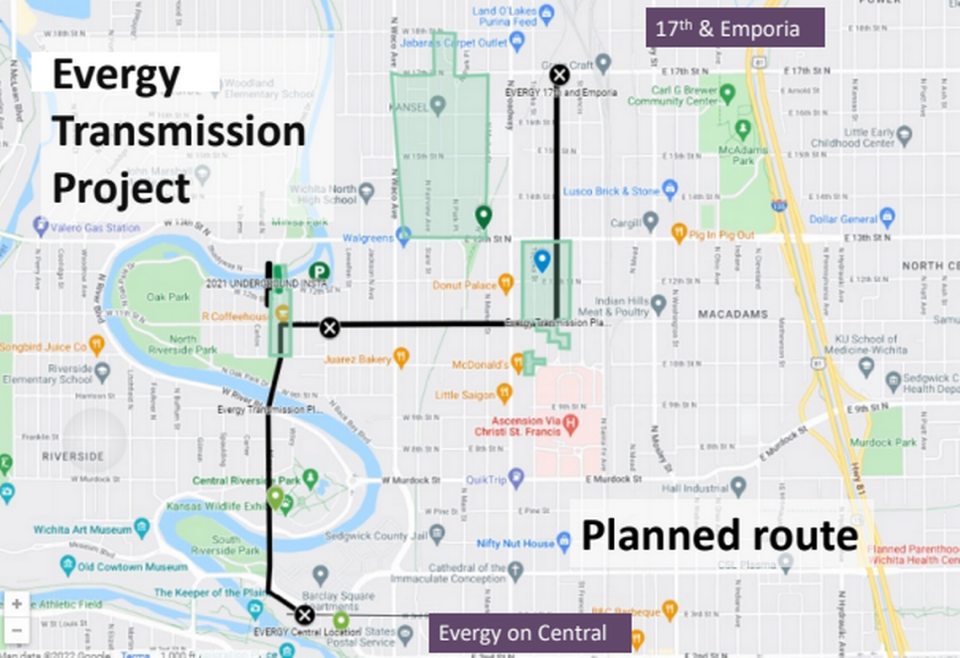Evergy rethinking plans to install towering power poles in two Wichita neighborhoods
Evergy is taking a step back from plans to erect new towering power poles that would run through Wichita’s Midtown and Riverside neighborhoods after community backlash to the proposal.
The existing transmission line, built in the 1950s, runs south from 17th Street and Emporia to 11th Street and Jefferson. A second phase of the rebuild would continue south down Nims to Central, near the Keeper of the Plains.
Vocal residents have banded together to express their displeasure for the proposed power poles, which they characterize as eyesores that could inflict permanent aesthetic harm on their neighborhoods.
When outrage over the installation of hulking 105-foot steel poles in northeast Wichita neighborhoods bubbled over in 2019, Evergy apologized and donated $1.25 million to benefit residents in the three ZIP codes affected by the pole replacement project.
“We don’t want them to mess up the neighborhood and then offer us some cash to shut up,” said Susan Cunningham, president of the Little Arkansas Community Coalition, the conservation and preservation group that’s spearheading community advocacy against the new power poles.
On Wednesday, the utility company confirmed it would re-evaluate its options before moving forward with the transmission line replacement.
“Evergy is reviewing suggestions from the community regarding the line. We are also taking a step back to look more holistically at planned projects in the heart of Wichita to maintain reliability,” Evergy spokesperson Kaley Bohlen said in a Wednesday email to The Eagle.

“At this early stage of the project, we don’t have specifics on pole location, size or material.”
Cunningham said residents have a number of alternative ideas for rerouting the line without disrupting neighborhoods, including the Park Place-Fairview Historic District, the Topeka Emporia Historic District and the North Topeka Avenue-10th Street Historic District in Midtown.
“Some people in Midtown want it to go down Santa Fe Street because that’s along the railroad tracks and it’s ugly over there anyway,” Cunningham said.
Bohlen said Evergy’s re-evaluation of plans “may take a few months, pushing out the timeline for this project.” There’s no concrete timeline, but Evergy officials have said the rebuild from 17th and Emporia to 11th and Jefferson will take about two years.
“This is several years down the road,” Cunningham said. “But we wanted to have a voice before the designers were done deciding where the poles were going and how many there were going to be, because once they get their design set, they very rarely change their minds.”
One option Bohlen says isn’t on the table is burying the transmission line underground.
“Cost and feasibility prevent undergrounding so we are focusing on alternatives that are possible,” she said. “In many places, room isn’t available to rebuild the transmission line underground because other utilities (natural gas and water lines, for example) are already underground in this area.”
John Carmichael, a Democrat who represents District 92 in the state House of Representatives and serves on the House Energy, Utilities and Telecommunications Committee, said advances in automation have made underground installation a viable option.
“It is now possible to bore these lines rather than install them through open trench excavation,” Carmichael said. “The cost of undergrounding the lines is decreasing relative to the cost of overhead lines, and so my hope is that Evergy is taking a look at the advancing technology and realizing that it may not be necessary to adversely impact neighborhoods with high-voltage transmission lines.”
Carmichael said the way Evergy handles this situation will be telling.
“What we don’t know in the long term is, is this a real change of attitude on Evergy’s part? Does it represent a decision that they have decided to respect historic neighborhoods and take the extra steps necessary to preserve those neighborhoods?” Carmichael said.
“Or is this a strategy that’s been used by other independently owned electric utilities in other locations whereby they announce an original plan for this type of expansion, then retract the plan and come up with multiple alternative routings, none of which are acceptable, and then the utility comes back and says, ‘Well, we proposed other routes but it was met with neighborhood opposition, and so therefore we’re going to go ahead and do what we intended to do in the first place.’”
Evergy, which serves 1.6 million customers across Kansas and Missouri, was created in 2018 with the merger of Topeka-based Westar Energy and Kansas City Power & Light, a Kansas City, Missouri, company.
In January, The Eagle reported that one major shareholder, Elliott Management Corp., was pressing Evergy to either increase profits or sell to owners who would follow its plan for investing more money in the power grid while cutting operation-and-maintenance spending and eliminating a program of buying back company stock.

